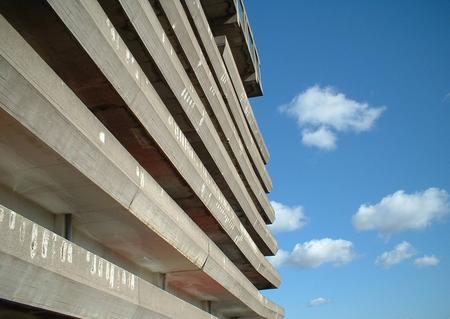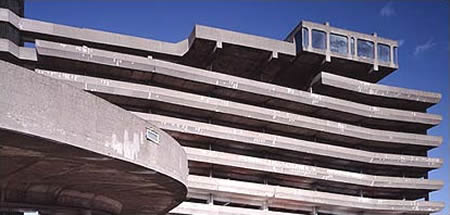

[first image from xlab]
The Trinity Car Park in Gateshead is due to be demolished. Famous for it's appearance in the film Get Carter (the Michael Caine version, not the Sylvester Stallion abherration), Trinity Car Park has long been a bellwether for the British attitude to Brutalism.
Completed in 1964 (Get Carter was filmed there in 1971), the complex it was never fully occupied. For instance the restaurant on the top was never used, and the car park itself was only used after 1969 due to cracking caused by deep mine shafts beneath the site.
Gateshead City Council promise exciting times ahead:
"Gateshead Council are working in partnership with Spen Hill Developments, the commercial development subsidiary of Tesco plc, on the regeneration of Trinity Square.
Situated in the heart of the town centre, the scheme will bring over multi million pound investment into the area and act as a catalyst for bringing further regeneration in the town centre.
This is a significant step towards the future of Gateshead’s centre and the delivery of a modern centre that people have told us they want. Elements of the 3.5 hectare site could include: a Tesco store, cafes and restaurants, apartments, cinema, car parking
I like the fact that Tesco's development company think that the redevelopment could include a Tesco store. And knocking down a car park to build, erm, a car park. Hmm.
This is not the first time Tesco have stuck the boot into the brutal. Opening a huge store next to the shopping centre in Cumbernauld has pretty much condemned it to the realm of pound shops and charity outlets.
And spare a thought for architect, Owen Luder. Having already seen the Tricorn Centre in Portsmouth pulled down (great pictures here), now it's the turn of the Trinity.
Speaking of the Tricorn Centre in 2004, Luder said:
"It was a design of the times. The early 1960s saw a very exciting expansion in architecture, we were pushing back the frontiers. The whole concept of pedestrianised shopping was totally new. I have no doubts about its design. It is a very positive building - you can't ignore it and people either love it or hate it.
"You can always mould into the surroundings and totally fit into the context and not get noticed - and many non-descript buildings do just that. But if you produce a big new building that is strange, with big shapes and new materials, people react to it and that is no bad thing - I want people to react to architecture."
All of which could equally apply to the Trinity.
The 20th Century Society, keen to preserve and restore the Trinity Car Park, held a study day in 2005 to find new uses for the Trinity.
"One group did not want to part from the idea of motorism in the building and suggested a racing track for local youths who would make this their building. Other ideas were for a business exhibition centre, a social hub and shelter for people in need, and a yoga, spa and dance centre. Another team started off taking a very practical and incredibly bold approach to the current situation: the students acknowledged Tesco’s interest in the site, and accommodated their supermarket on the first two floors and a restaurant in the spectacular box on top of the building, with parking in between. This was a real eye-opener and showed that really all that is needed is already there."
But Tesco have never been known for any kind of architectural quality or experimentation. Instead over the last 30 years they have littered the landscape of Britain with a series of Frankenstein neo-vernacular barns set in a tarmac sea of parking.
More on the Tescofication of Britain another time.
